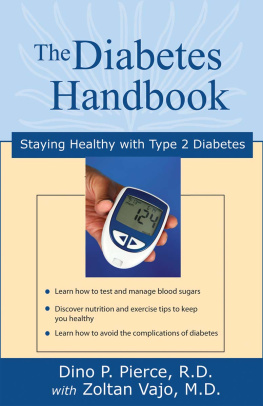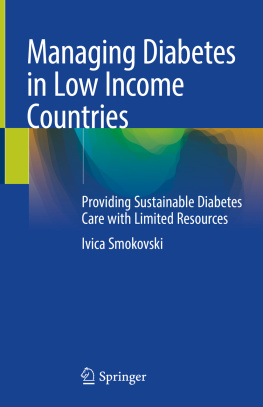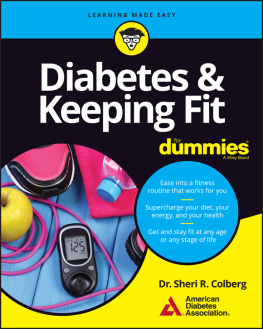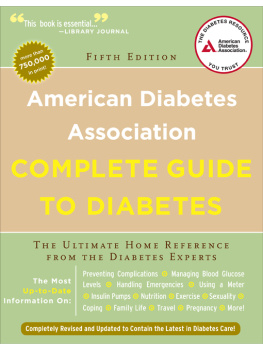
Director, Book Publishing, Abe Ogden; Managing Editor, Greg Guthrie; Acquisitions Editor, Victor Van Beuren; Production Manager, Melissa Sprott; Copyediting, Cenveo; Composition, ADA; Cover Design, Kim Woody; Printer, Versa Press, Inc.
2013 by the American Diabetes Association, Inc. All Rights Reserved. No part of this publication may be reproduced or transmitted in any form or by any means, electronic or mechanical, including duplication, recording, or any information storage and retrieval system, without the prior written permission of the American Diabetes Association.
Printed in the United States of America
1 3 5 7 9 10 8 6 4 2
The suggestions and information contained in this publication are generally consistent with the Clinical Practice Recommendations and other policies of the American Diabetes Association, but they do not represent the policy or position of the Association or any of its boards or committees. Reasonable steps have been taken to ensure the accuracy of the information presented. However, the American Diabetes Association cannot ensure the safety or efficacy of any product or service described in this publication. Individuals are advised to consult a physician or other appropriate health care professional before undertaking any diet or exercise program or taking any medication referred to in this publication. Professionals must use and apply their own professional judgment, experience, and training and should not rely solely on the information contained in this publication before prescribing any diet, exercise, or medication. The American Diabetes Associationits officers, directors, employees, volunteers, and membersassumes no responsibility or liability for personal or other injury, loss, or damage that may result from the suggestions or information in this publication.
 The paper in this publication meets the requirements of the ANSI Standard Z39.48-1992 (permanence of paper).
The paper in this publication meets the requirements of the ANSI Standard Z39.48-1992 (permanence of paper).
ADA titles may be purchased for business or promotional use or for special sales. To purchase more than 50 copies of this book at a discount, or for custom editions of this book with your logo, contact the American Diabetes Association at the address below, at booksales@diabetes.org, or by calling 703-299-2046.
American Diabetes Association
1701 North Beauregard Street
Alexandria, Virginia 22311
DOI: 10.2337/9781580404853
Library of Congress Cataloging-in-Publication Data
Colberg, Sheri, 1963
Exercise and diabetes : a clinician's guide to prescribing physical activity / Sheri R. Colberg, PhD, FACSM.
pages cm
Includes bibliographical references and index.
ISBN 978-1-58040-485-3 (alk. paper)
1. Diabetes--Exercise therapy. 2. Diabetics--Rehabilitation. I. Title.
RC661.E94C652 2012
616.4'620642--dc23
2012038644
eISBN: 978-1-58040-507-2
For my loving husband, Ray,
and my three wonderful sons, Alex, Anton, and RayJ.
Thanks for your nonstop support and boundless love.
Contents
I. Getting Started with Physical Activity
II. Prescribing Exercise by Activity and Diabetes Type
III. Preventing Acute Exercise-Related Problems
IV. Exercising with Comorbid Health Issues
V. Staying Physically Active for Life
M yriad types of physical movement have a positive impact on physical fitness, morbidity, and mortality in individuals with diabetes, and although exercise has long been considered a cornerstone of diabetes management, many health-care providers fail to prescribe it. Many fitness professionals may be unaware of the complexities of including physical activity in the management of all types of the disease. Giving patients or clients a full exercise prescription that takes comorbid conditions into account may be too time-consuming for or beyond the expertise of many health-care and fitness professionals.
The purpose of this book, therefore, is to cover the recommended types and quantities of physical activities that can and should be undertaken by all individuals with any type of diabetes, along with precautions related to medication use and diabetes-related health complications. Medications used to control diabetes should augment, rather than replace, lifestyle improvements like increased daily physical activity.
Until now, professional books with exercise information and prescriptions were not timely or sufficiently interactive to easily provide busy professionals with access to the latest recommendations for each unique patient. Simply instructing patients to exercise more is not motivating or informative enough to get them regularly or safely active. Exercise and Diabetes is changing all that with its up-to-date and easy-to-prescribe exercise and physical activity recommendations and relevant case studies.
Read, learn, and quickly be ready to effortlessly prescribe effective and appropriate exercise to everyone. Your reward will be a collective increase in the health and fitness of all people with diabetes.
Aerobic exercise: Physical movement that results from rhythmic muscular contractions that are primarily fueled by the aerobic metabolism of energy in the body; oxygen-based generation of energy is usually the main source for any activity lasting longer than 2 min continuously.
Autonomic neuropathy: Disease affecting the nerves innervating the heart, gastrointestinal, and genitourinary tract; cardiovascular autonomic neuropathy (CAN) is the most common, studied, and clinically important type of this neuropathy.
Cardiorespiratory (aerobic) fitness: The ability of the circulatory and respiratory systems to supply oxygen to skeletal muscles during sustained (aerobic) physical activity.
Continuous glucose monitoring (CGM): Newer technologies that allow for subcutaneous monitoring of glucose levels with frequent readings (usually every 5 min).
Daily lifestyle activity: All physical activities done during the course of a day involved with self-care, basic locomotion, and other movement other than planned exercise sessions (also called activities of daily living [ADL]).
Diabetic ketoacidosis (DKA): High level of blood ketones (e.g., -hydroxybutyrate, acetoacetate, acetone), accompanied by hyperglycemia, that can result in coma or death if not treated in a timely manner.
Estimated average glucose (eAG): Alternate method to report hemoglobin A1C levels, as an estimated average glucose in mg/dl instead of percent (e.g., A1C value of 6.0% equates to an eAG of 126 mg/dl); the relationship between A1C and eAG is described by the formula (28.7 A1C) 46.7 = eAG. An online calculator is available at professional.diabetes.org/GlucoseCalculator.aspx.
Gestational diabetes mellitus (GDM): A hyperglycemic condition developing most often during the third trimester of pregnancy (when placental hormones decrease insulin action); although it usually resolves postpartum, it is associated with a greater risk for the mother of developing type 2 diabetes later in life.
Hemoglobin A1C (or A1C): Test to assess glycemic control that reflects a time-averaged blood glucose concentration (as a percent) over the previous 23 months; a normal value is ~4.06.0%.
Hyperglycemia: An elevated blood glucose level (i.e., blood glucose 126 mg/dl).
Hypoglycemia: An abnormally low blood glucose level (i.e., blood glucose <70 mg/dl).
Insulin resistance: A condition in which there is a relative lack of insulin action in insulin-sensitive tissues (primarily skeletal muscle) needed to maintain normal glucose levels.
Next page








![Sheri Colberg-Ochs [SHERI R COLBERG] - The 7 step diabetes fitness plan : living well and being fit with diabetes, no matter your weight](/uploads/posts/book/102363/thumbs/sheri-colberg-ochs-sheri-r-colberg-the-7-step.jpg)


 The paper in this publication meets the requirements of the ANSI Standard Z39.48-1992 (permanence of paper).
The paper in this publication meets the requirements of the ANSI Standard Z39.48-1992 (permanence of paper).